Czichos H., Saito T., Smith L.E. (Eds.) Handbook of Metrology and Testing
Подождите немного. Документ загружается.

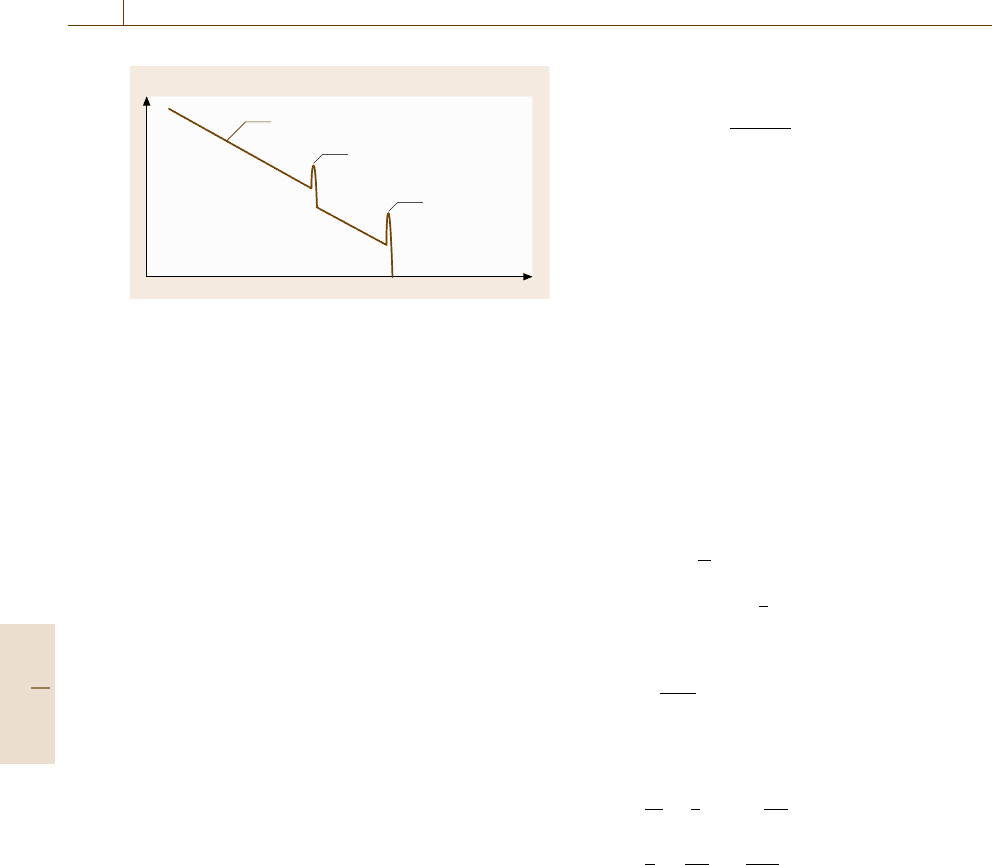
628 Part C Materials Properties Measurement
log (return signal)
Time
Slope yields fiber attenuation
Connector
Break
Fig. 11.63 Typical OTDR signal. OTDR can be used for
attenuation measurement, splice and connector loss
fiber to strip off the unfavorable lossy modes [11.71].
In the case of multimode fiber the situation becomes
more delicate because the attenuation depends on the
modes, i. e. higher-order modes have higher losses. So,
we should try to excite modes evenly and wait until
the mode equilibrium is established through mode con-
version. This may need a considerable length of fiber,
typically ≈1km.
Nondestructive loss measurement has now become
possible with the technological advancement of low-
loss single-mode splices or connectors, simply by
assuring that the connector loss is much smaller than
the fiber loss.
Optical time-domain reflectometry (OTDR)isan-
other nondestructive evaluation method for attenuation.
In this method the fiber is excited with a narrow laser
pulse and a continuous backscattering signal from the
fiber is recorded as a function of time. Assuming a linear
and homogeneous backscattering process the decrease
in backscattered light with time reflects the round-trip
attenuation as a function of distance.
Figure 11.63 shows a typical OTDR signal. The lin-
ear slope yields the fiber attenuation and the sudden
drop in intensity represents the splice loss; the narrow
peak indicates a reflection. The OTDR method enables
the evaluation of the loss distribution along the fiber in-
cluding splice loss even in the deployed fiber. OTDR is
also very sensitive to the excitation condition into the
fiber, so control of the launch condition is the key for all
attenuation measurement of fibers.
Chromatic Dispersion
The refractive index of every material depends on
the optical frequency; this property is referred to as
chromatic dispersion. In the spectral region far from
absorption the index is well-approximated by the Sell-
meier equation. For bulk fused silica n(λ) is expressed
by the equation,
n(ω)
2
=1+
m
j=1
B
j
ω
2
j
ω
2
j
−ω
2
,
where ω
j
is the resonance frequency and B
j
is
the strength of the jth resonance. For bulk fused
silica, these parameters are found to be B
1
=
0.6961663, B
2
= 0.4079426 and B
3
= 0.8974794,
λ
1
= 0.0684043 μm, λ
2
= 0.1162414 μm, and λ
3
=
9.896161 μm [11.72], where λ
j
=2πc/ω
j
and c is the
speed of light.
Dispersion plays a critical role in the propagation
of short optical pulses because the different spectral
components propagate with different speeds, given by
c/n(ω). This causes dispersion-induced pulse broaden-
ing, which is detrimental for optical communication
systems. The effect of chromatic dispersion can be
analyzed by expanding the propagation constant β in
a Taylor series around the optical frequency ω
0
on
which the pulse spectrum is centered.
β(ω) =n(ω)
ω
c
=β
0
+β
1
(ω −ω
0
)
+
1
2
β
2
ω −ω
2
0
+···,
where
β
m
=
d
m
β
dω
m
ω=ω
0
(m = 0, 1, 2, 3,...) .
The parameter β
1
and β
2
are related to the refractive
index n through the relations
β
1
=
1
v
g
=
1
c
n +ω
dn
dω
,
β
2
=
1
c
2
dn
dω
+ω
d
2
n
dω
2
,
where v
g
is the group velocity. The envelope of the
optical pulse moves at the group velocity. The pa-
rameter β
2
, which is a measure of the dispersion of
group velocity, is responsible for the pulse broadening.
This phenomenon is known as group velocity disper-
sion (GVD). In bulk fused silica, the GVD parameter
β
2
decreases with increasing wavelength, vanishes for
wavelengths of about 1.27 μm and becomes negative
for longer wavelengths. This wavelength is referred to
as the zero-dispersion wavelength, denoted by λ
D
.
The dispersion behavior of actual silica fiber devi-
ates from the bulk fused silica case for the following
two reasons. First, the fiber core usually has small
Part C 11.5
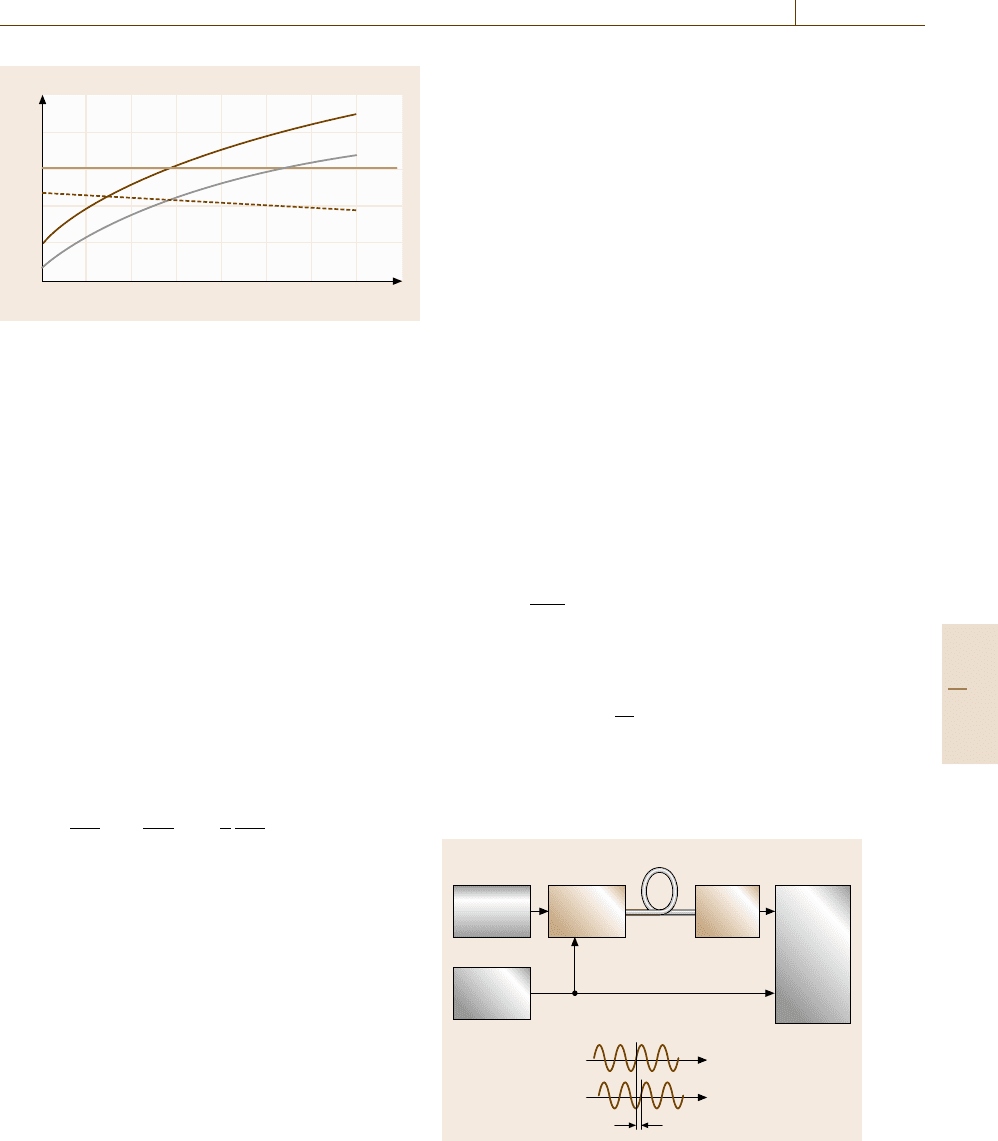
Optical Properties 11.5 Fiber Optics 629
40
20
0
–20
–40
–60
1 1.1 1.2 1.3 1.4 1.5 1.6 1.7 1.8
Wavelength (μm)
D (ps/km ⋅ nm)
Fig. 11.64 Wavelength dependence of the dispersion pa-
rameter D for dispersion-shifted fiber (brown line). Brown
curve and dotted line represent D for silica bulk material
and wave-guide dispersion, respectively
amounts of dopants such as GeO
2
and P
2
O
5
.Inthis
case, we should use the Sellmeier equation with pa-
rameters appropriate to the amount of doping [11.73].
Second, because of dielectric waveguiding, the effec-
tive mode index reflects the field distribution in the core
and cladding and is slightly lower than the material
index n(ω) of the core. The field distribution itself de-
pends on ω, and this results in what is commonly termed
waveguide dispersion [11.74]. Waveguide dispersion
is relatively small except near the zero-dispersion
wavelength λ
D
, so the main effect of the waveguide
contribution is to shift λ
D
toward longer wavelengths;
λ
D
=1.31 μm for standard single-mode fiber.
The dispersion parameter D (ps/km · nm) is com-
monly used in fiber optic literature in place of β
2
. D is
related to β
2
by the relation.
D =
dβ
1
dλ
=−
2πc
λ
2
β
2
≈
λ
c
d
2
n
dλ
2
An important aspect of waveguide dispersion is that
the contribution to D depends on design parameters
such as the core radius a and the core–cladding in-
dex difference Δ. As shown in Fig. 11.64 this feature
was used to shift the zero-dispersion wavelength λ
D
in
the vicinity of 1.55 mm where the fiber loss is at its
minimum [11.74]. Such dispersion-shifted fibers, called
zero- and nonzero-dispersion shifted fibers, depending
on whether D =0at1.55 μm or not, play an important
role in optical communication network systems.
Dispersion Measurements
Optical pulse method is a simple time-domain mea-
surement. Pulse delay through an optical fiber is directly
measured as a function of wavelength [11.75]. This
system usually consists of a fast optical pulse gener-
ator with a tunable laser source and a fast waveform
monitor system, which are common to instruments
characterizing optical transmission lines. However, the
accuracy is limited by optical pulse distortion due to
dispersion and the time resolution of the waveform
monitor.
Phase shift method is the prevailing method be-
cause higher time-domain resolution can be ob-
tained with a relatively low frequency modulation
(< 3 GHz) [11.76]. The measurement scheme is shown
in Fig. 11.65.
A tunable light source like an external cavity laser
is usually used as the light source. The light is modu-
lated by a sinusoidal wave at a frequency of f
m
with
aLiNbO
3
Mach–Zender modulator. The optical signal
propagated through a test fiber is converted to an electri-
cal signal and then compared with the reference signal
using a phase comparator. The phase difference φ(λ)is
measured as a function of the wavelength λ. The group
velocity delay τ(λ)(s/km) for an optical fiber of length
L (km) is obtained by the equation
τ(λ) =
φ(λ)
f
m
L
,
where τ(λ) is supposed to be approximated by a three-
term Sellmeier equation
τ(λ) = Aλ
2
+B +
C
λ
2
.
Usually, the A, B and C parameters are determined from
the delay data and the GVD value is then obtained by
differentiating the curve with respect to λ.
Reference
Signal
Reference
Sample fiber
Tunable
laser
AM
modulator
O/E con-
verter
Phase
compa-
rator
μ
f
m
Oscillator
t
t
Phase difference φ(μ)
Fig. 11.65 Diagram for dispersion measurement by the
phase-shift method
Part C 11.5
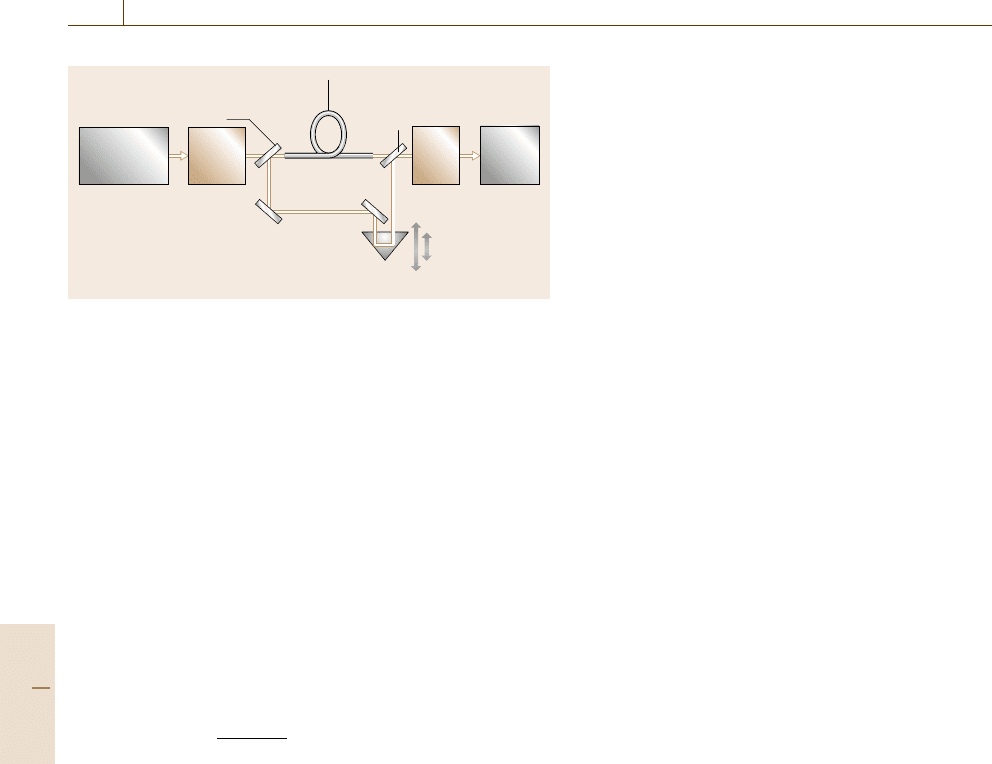
630 Part C Materials Properties Measurement
Broad-band
light source
Mirror
Corner cube
Modulation
Linear translation
BS
Beam splitter
(BS)
Sample fiber
(1–2 m)
Optical
delay pass
Optical
filter
O/E
con-
verter
Signal
proces-
sor
Fig. 11.66 Measurement scheme for the interference measurement
method
Interference measurement method is appropriate for
short fiber lengths, and allows a detailed and direct com-
parison of the optical phase shifts between a test fiber
and a reference arm. This measurement scheme is illus-
trated in Fig. 11.66 [11.77].
A broadband light source like white light or an LED
is used as the light source in order to reduce the co-
herence length. Typically, a tunable optical filter with
a bandwidth of around 10 nm is introduced in front of
the interferometer. A free-space delay line or optical
fiber of which the GVD is well-known is utilized as the
reference arm. By moving the modulated corner cube,
the position d corresponding to the zero-pass interfer-
ence peak is detected. The group velocity delay τ(λ)for
the test fiber is expressed by
τ(λ) =
2(d −d
0
)
c
,
where d
0
is the zero-pass difference position at the ref-
erence wavelength and c is the velocity of light. The
GVD is also estimated by differentiating the smoothed
τ(λ) curve with respect to λ.
11.5.2 Nonlinear Optical Properties
This subsection deals with the nonlinear optical prop-
erties of fiber. The low loss and long interaction length
of optical fibers make nonlinear processes significant.
Stimulated Raman and Brillouin scattering limits the
power-handling ability of fibers. Four-wave mixing
presents an important limit on the channel capacity
in wavelength division multiplexing (WDM) systems.
Soliton formation and nonlinear polarization evolution
are also summarized.
The small cross section and long interaction length
of optical fiber make nonlinear optical process signifi-
cant even at modest power levels. Recent developments
in fiber amplifiers have increased the available power
level drastically. Optical nonlinearities are usually detri-
mental to optical communication networks and put
some limits on the power-handling ability of fibers in
medical and industrial applications. On the other hand,
these optical nonlinearities are utilized in the generation
of ultra-short pulse, soliton-based signal transmission,
and Raman amplifiers.
As SiO
2
is a symmetric molecule, the second-order
nonlinear susceptibility χ
(2)
vanishes for silica glasses.
So, nonlinear effects in optical fibers originate from
the third-order susceptibility χ
(3)
, which is responsi-
ble for phenomena such as third-harmonic generation,
four-wave mixing and nonlinear refraction.
In the simplest form, the refractive index can be
written as
n(ω, I) =n(ω) +n
2
I .
Self-phase modulation (SPM) is the most important
phenomena among the various nonlinear effects arising
from the intensity dependence of the refractive index.
The self-induced phase shift experienced by an optical
field during its propagation is
φ = (n +n
2
I)k
0
L ,
where k
0
=2π/λ and L is the length of the fiber.
The measured n
2
value for bulk silica at 1.06 μm
is 2.7×10
−20
m
2
/W [11.78]. Measured values for var-
ious silica optical fibers are found to be in the range
2.2–3.9×10
−20
m
2
/W [11.79]. The scatter of the data
may be partly ascribed to the difference of the doping in
the core materials of the fibers.
Pulse Compression and Solitons
Figure 11.67 illustrates what happens to an optical pulse
which propagates in a nonlinear optical medium. The
local index change raises so-called self-phase modula-
tion. Since n
2
is positive, the leading edge of the pulse
produces a local increase in refractive index. This re-
sults in a red shift in the spontaneous frequency. On
the other hand, the pulse experiences a blue shift on the
trailing edge.
If the fiber has a normal dispersion at the central
wavelength of the optical pulse, the red-shifted edge
will advance and the blue-shifted trailing edge will re-
tard, resulting in pulse spreading in addition to the
normal chromatic dispersion. However, if fiber exhibits
anomalous dispersion, the red-shifted edge will retard
and the optical pulse will be compressed. Near the dis-
persion minimum, the optical pulse is stabilized and
Part C 11.5
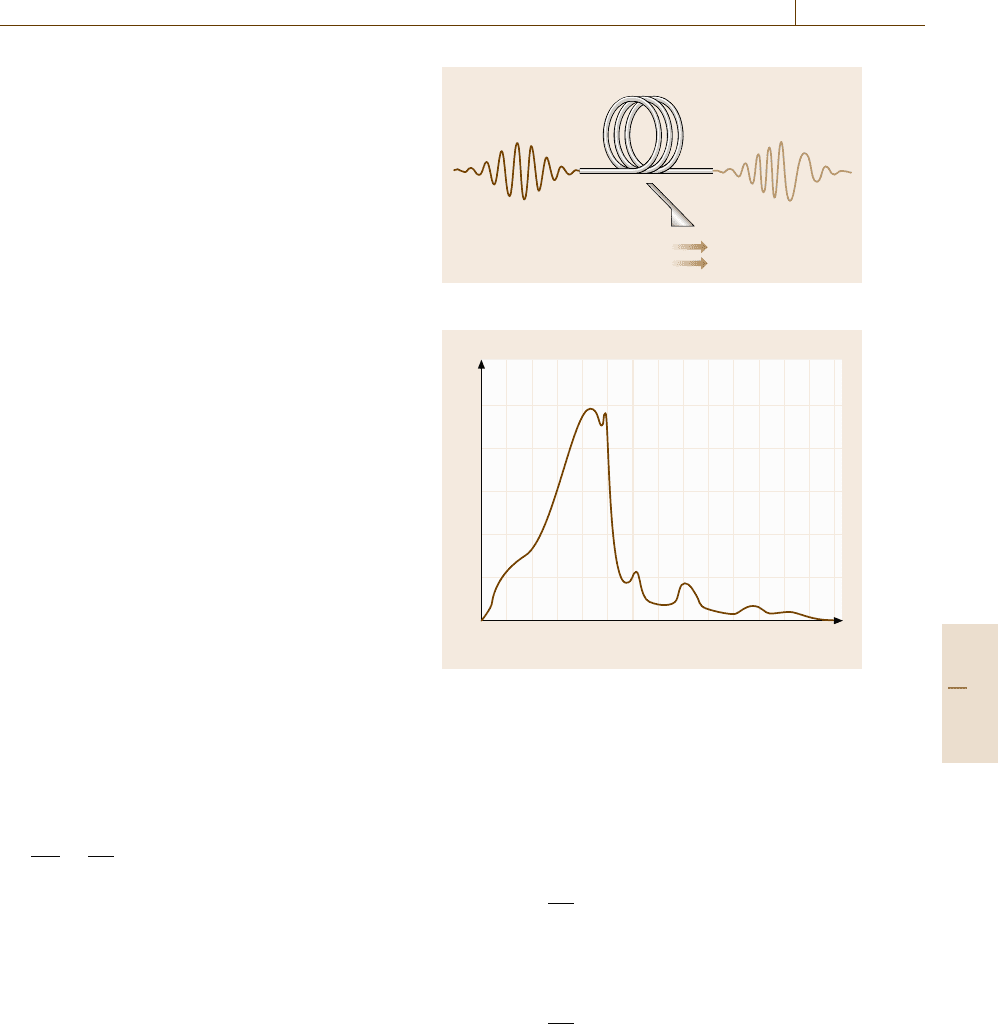
Optical Properties 11.5 Fiber Optics 631
propagates without changing shape at a critical shape.
This optical pulse is called a soliton [11.80]. A soli-
ton requires a certain power level in order to maintain
the necessary index change. The record for soliton
transmission is now well over 10 000 km, which was
achieved by utilizing the gain section of a stimulated
Raman amplifier or a rare-earth-doped fiber amplifier.
In the laboratory, optical fiber nonlinearity is used in
the mode-locked femtosecond laser [11.81, 82]andthe
generation of white continuum [11.83].
Third-harmonic generation and the four-wave mix-
ing effect are based on the same χ
(3)
nonlinearity but
they are not efficient in optical fibers because of the
difficulty in achieving the phase-matching condition.
However, WDM signal transmission systems encounter
serious cross-talk problems arising from four-wave
mixing between the WDM channels near the zero-
dispersion wavelength of 1.55 μm [11.85].
The nonlinear optical effects governed by the
third-order susceptibility are elastic, so no energy is
exchanged between the electromagnetic field and the
medium. Another type of nonlinear effect results from
stimulated inelastic scattering, in which the optical field
transfers part of its energy to the nonlinear medium.
Two such scattering process are important in opti-
cal fiber: 1) stimulated Raman scattering (SRS), and
2) stimulated Brillouin scattering (SBS).
The main difference between the two is the phonon
participating in the process; optical phonons participate
in SRS while acoustic phonons participate in SBS.In
optical fiber SBS occurs only in the backward direction
while SRS can occur in both directions. The equation
governing the growth of the Raman-shifted mode is as
follows
dI
S
dz
=
g
R
a
eff
I
P
−αI
S
,
where I
S
is the Stokes intensity, I
p
is the pump inten-
sity and a
eff
is the effective area of the modes. g
R
is
Raman gain coefficient. The same equation holds for
SBS by replacing g
R
with the Brillouin gain coefficient
g
B
. The Raman gain spectrum in fused silica is shown
in Fig. 11.68.
The Raman gain spectrum of silica fiber is broad,
extending up to 30 THz [11.84] and the peak gain
g
R
=10
−13
m/W occurs for a Stokes shift of ≈13 THz
for a pump wavelength near 1.5 μm. In contrast to
Raman scattering, Brillouin gain is extremely narrow
with a bandwidth < 100 MHz and the Stokes shift is
≈1 GHz close to 1.5 μm.
Optical fiber
Transmitted optical
waveform
Incident optical
waveform
Leading edge of pulse
Trailing edge of pulse
Red shift
Blue shift
Fig. 11.67 Pulse evolution in a nonlinear medium
1.2
1.0
0.8
0.6
0.4
0.2
0
0 200 400 600 800 1000 1200 1400
Frequency shift (cm
–1
)
Raman gain coefficient (cm/W)
×10
–11
(μ
pump
= 1.0 μm)
Fig. 11.68 Raman gain spectrum in fused silica (af-
ter [11.84])
SRS and SBS exhibit a threshold-like behavior
against pump power. Significant conversion of pump
energy to Stokes radiation occurs only when the pump
intensity exceeds a certain threshold level. For SRS in
a single mode fiber with αL 1, the threshold pump
intensity is given by [11.86]
I
th
P
=16α
a
eff
g
R
.
SRS can be observed at a power level of ≈ 1W. Sim-
ilarly, the threshold pump intensity for SBS is given
by [11.86]
I
th
P
=21α
a
eff
g
R
.
The Brillouin gain coefficient g
B
=6×10
−11
m/Wand
is larger by three orders of magnitude compared with
g
R
.So,SBR threshold is ≈ 1mW for CW narrow-
bandwidth pumping.
Silica fibers with large effective cross section and
short length have a significantly higher power-handling
Part C 11.5
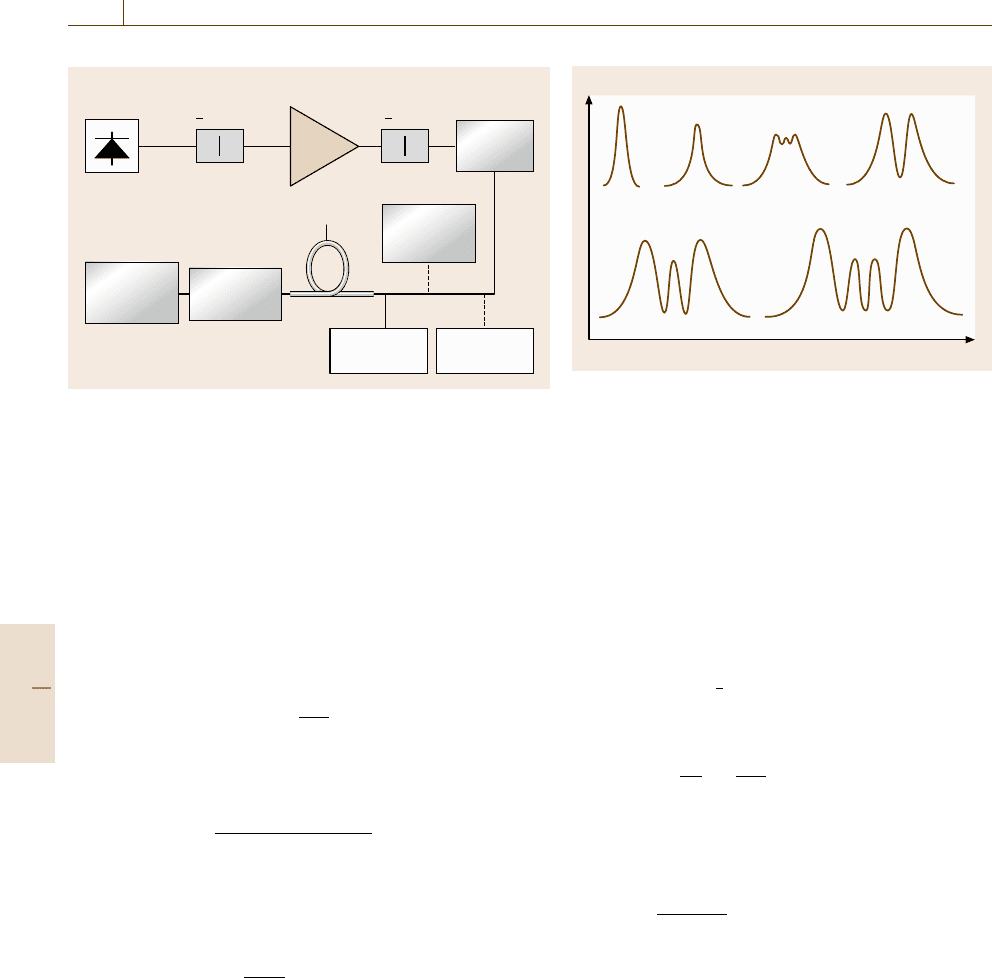
632 Part C Materials Properties Measurement
Gain-switched
DFB-LD
OBPF
~
0.1 nm
OBPF
~
1nm
EDFA
Optical
attenuator
Optical
sampling
oscilloscope
Optical
sampling
oscilloscope
Fiber under test
Fabry–Pérot
etalon
Optical
powermeter
Wavelength
meter
Fig. 11.69 Schematic diagram of the measurement of optical non-
linearity of fiber based on the self-phase modulation method
ability and the broad-spectrum operation helps to in-
crease the power-handling ability of the fiber.
Measurement of Nonlinear Refractive Index n
2
The nonlinear refractive index is expressed by the equa-
tion,
n(ω, E
2
) =n(ω) +n
2
E
2
,
In order to characterize the nonlinearity of the fiber, it is
more practical to use the following equation.
n(ω, P) =n(ω) +
n
2
A
eff
P
where P is the power propagating in the fiber and A
eff
is
the effective area of fiber defined by the equation, [11.80]
A
eff
=
2π
∞
0
|
E(r)
|
2
r dr
∞
0
E(r)
4
r dr
,
where E(r) presents the field distribution in the fiber;
A
eff
is approximately related to the mode field diameter
(MFD) by the following equation
A
eff
≈π
MFD
2
2
.
For reliable evaluation of the nonlinearity of fiber,
a variety of methods have been developed based on
self-phase modulation [11.87–89], cross-phase modu-
lation [11.90], four-wavemixing [11.91] and interferom-
etry.
Figure 11.69 shows a measuring system based on
self-phase modulation developed by Namihira et al.
[11.87]. The output of a gain-switched DFB-LD with
0.5 π
Intensity
Frequency
π 1.5 π0
2.5 π 3.5 π
Fig. 11.70 Spectral evolution due to the self-phase modula-
tion as a function of incident power (after [11.87])
a pulse width of 26.5 ps is filtered by a narrow-band filter
with a bandwidth of 0.1 nm to get a nearly transformation-
limited beam. The beam is amplified by an Er-doped
fiber amplifier (EDFA), and is introduced into a test fiber
through a variable optical attenuator. The optical spectra
of the fiber output are measured by a Fabry–Pérot inter-
ferometer. The observed output spectra from the fiber for
various input powers is shown in Fig. 11.70 [11.87]. The
number of observed spectral peaks M is related to the
maximum phase shift, Φ
max
by the equation
Φ
max
=
M −
1
2
π,
Φ
max
is also the related to (n
2
/A
eff
) by the equation
Φ
max
=
2π
λ
n
2
A
eff
L
eff
P
0
,
where P
0
is the incident power into the test fiber and L
eff
is the effective length of fiber and expressed by the equa-
tion,
L
eff
=
1 − e
−αL
α
,
where α is the absorption coefficient and L is the length
of the test fiber. (n
2
/A
eff
) can be estimated from the slope
of Φ
max
against P
0
.
11.5.3 Fiber Bragg Grating
The ohotosensitivity of silica fiber was discovered in
1978 by Hill et al. at the Communications Research
Center in Canada [11.92]. Fiber Bragg grating (FBG)
devices based on these phenomena allow the integration
of sophisticated filtering and dispersion functions into
Part C 11.5
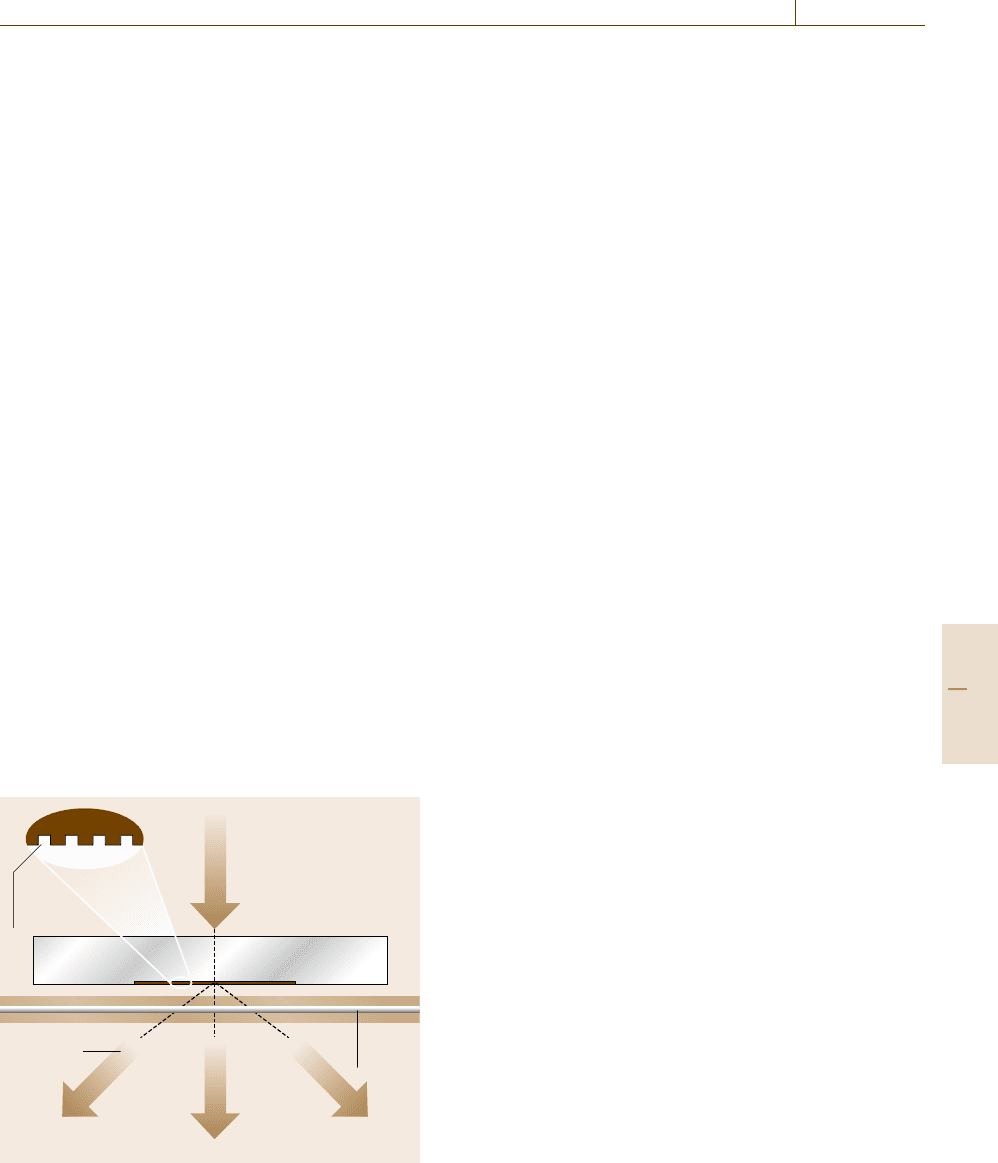
Optical Properties 11.5 Fiber Optics 633
a fiber and have many applications in optical fiber com-
munication and optical sensor systems. This subsection
summarizes FBG technology and their properties. More
information on FBGs can be found in the following
references [11.93–95].
Photosensitivity
When ultraviolet light radiates an optical fiber, the re-
fractive index is changed permanently; this effect is
called photosensitivity. The change in refractive in-
dex is permanent if the fiber is annealed appropriately.
These phenomena were first discovered in a fiber with
a germanium-containing core, and have been observed
in a variety of different fibers. However, optical fiber
with germanium-containing core remains the most im-
portant material for FBG devices. 248 and 198 nm
radiation from KrF and ArF lasers with a pulse width
of ≈10 ns at a repetition rate of ≈ 100 pps are most
commonly used. Typically fibers are exposed to laser
light for a few minutes at irradiation levels in the
range 100–1000 mJ/cm
2
. Under these conditions, the
index change Δn of fibers with germanium-containing
cores is in the rage between 10
−5
–10
−3
. Irradiation
at higher intensities introduces the onset of different
kinds of photosensitive processes, leading to a phys-
ical damage. The index change can be enhanced by
processing fibers prior to irradiation with hydrogen-
loading [11.96] and flame-brushing [11.97] techniques.
(Photoinduced index changes up to 100 times greater
are obtained by hydrogen loading for a Ge-doped core
fiber, and a ten times increase in the index change
can be achieved using flame brushing.) The physical
Grating
corrugations
Incident
ultraviolet
light beam
Silica glass phase grating
(zero order suppressed)
Diffracted
beams
Zero order
Fiber
core
–1st order +1st order
Fig. 11.71 FBG fabrication with phase mask technique
process underling photosensitivity is not completely un-
derstood, however it is believed to be related to the
bleaching of the color centers in the ultraviolet spectral
range.
Fabrication Techniques
Many techniques have been developed for the fabri-
cation of FBG, e.g. the transverse holographic tech-
nique [11.98], the phase mask technique [11.99]and
the point-by-point technique [11.100]. The phase mask
technique is the most common because of its sim-
ple manufacturing process, high performance and great
flexibility.
Figure 11.71 shows a schematic diagram of the
phase mask technique for the manufacture of FBGs.
The phase mask is made from a flat silica-glass slab
with a one-dimensional periodic structure etched using
photolithography techniques.
The phase mask is placed almost in contact with the
optical fiber at a right angle to the corrugation and the
ultraviolet light is incident normal to the phase mask.
Most of the diffracted light is scattered in the +1and
−1 orders because the depth of the corrugation is de-
signed to suppress diffraction into the zeroth order. If
the period of the phase mask grating is Λ, the period
of the photoimprinted FBG is Λ/2, which is indepen-
dent of the wavelength of the irradiated ultraviolet.
The phase mask technique greatly simplifies the man-
ufacturing process and its low coherence requirement
on the ultraviolet beam permits the use of a conven-
tional excimer laser. The phase mask technique not only
yields high-performance devices, but is very flexible,
i. e. apodization and chirping techniques are easily in-
troduced to control the spectral response characteristics
of the FBGs [11.101].
Another approach to the manufacture of FDB grat-
ings is the point-by-point technique, in which each
index perturbation is written point by point. This tech-
nique is useful for making long-period FBG devices that
are used for band-rejection filters and fiber-amplifier
gain equalizers.
Properties of FBGs
Light propagating in an FBG is backscattered by Fres-
nel reflection from each successive index change. The
back reflections add up coherently in the region of the
Bragg wavelength, λ
B
and cancel out in the other wave-
length regions.
The reflectivity of strong FBGs can approach 100%
at the Bragg wavelength, whereas the light in the other
spectral region passes through the FBG with negligible
Part C 11.5
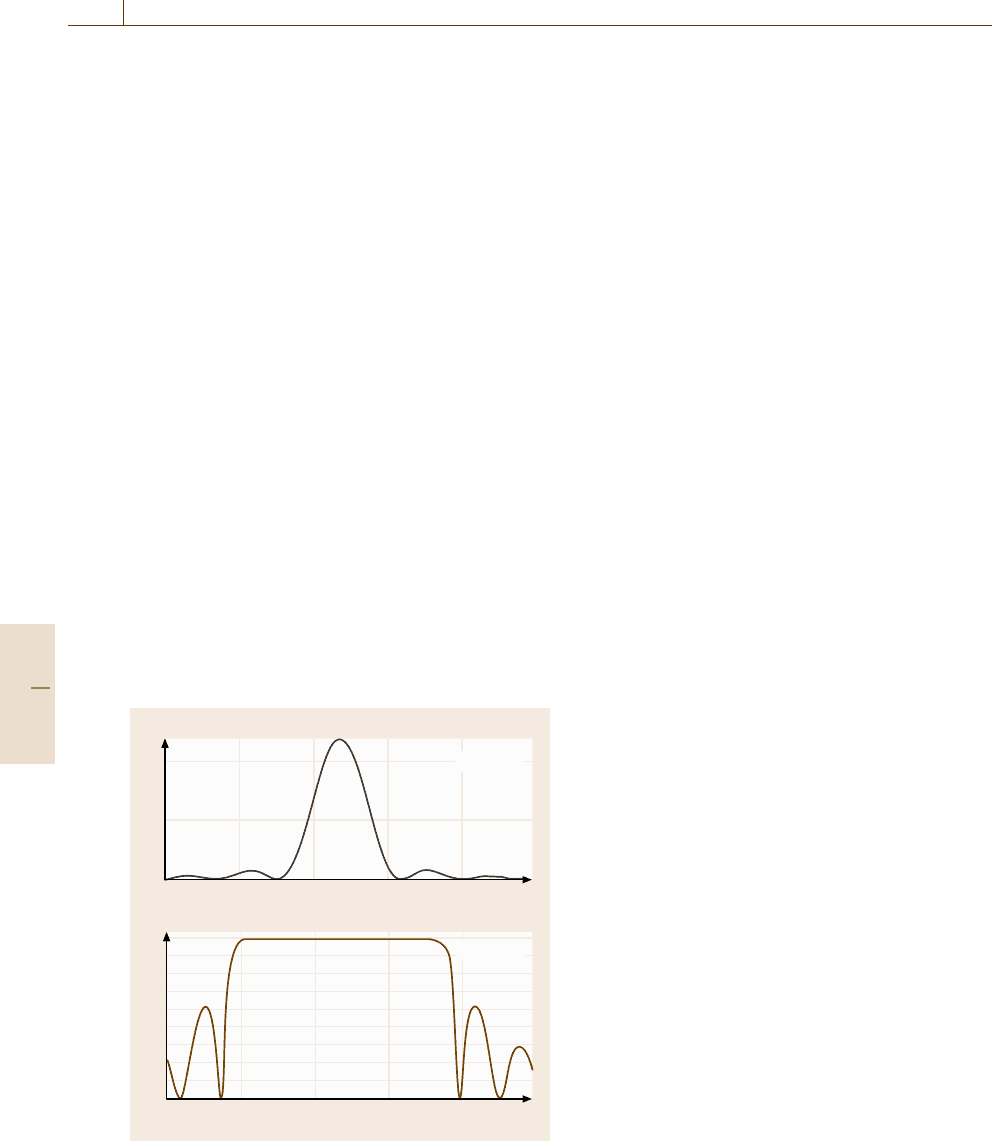
634 Part C Materials Properties Measurement
loss. The Bragg wavelength λ
B
is given by
λ
B
=2N
eff
Λ,
where N
eff
is the modal index of the fiber and Λ is the
grating period.
The Bragg grating can be described theoretically
by using coupled-mode equations [11.102]. Here im-
portant properties are summarized for the tightly bound
single-mode propagation through a uniform grating. The
grating is assumed to have a sinusoidal index profile with
amplitude Δn. The reflectivity R of the grating at the
Bragg wavelength is expressed by the simple equation,
R =tanh
2
(κL) where k =(π/λ)Δn is the coupling coef-
ficient and L is the length of the grating. The reflectivity
is determined by κ L, and a grating with a κL greater than
one is termed a strong grating whereas a weak grating
has a κL less than one. Figure 11.72 shows the typical
reflection spectra for weak and strong gratings.
The other important property of FBGs is the reflec-
tion bandwidth. In the case of weak coupling (κL < 1),
the Δλ
FWHM
is approximated by the spectral distance
from the Bragg wavelength, λ
B
to the neighboring dip
wavelength, λ
D
; Δλ
FWHM
≈(λ
0
−λ
B
) =λ
2
B
/(2N
eff
L).
The bandwidth of a weak grating is inversely propor-
tional to the grating length and can be very narrow
for a long grating. On the other hand, in the case of
strong coupling (κ L > 1), Δλ
FWHM
is approximated
by the wavelength difference between the adjacent re-
0.2
0.1
0.0
1.0
0.9
0.8
0.7
0.6
0.4
0.3
0.2
0.1
0.0
1549.6 1549.7 1549.8 1549.9 1550.0 1550.1
1549.6 1549.7 1549.8 1549.9 1550.0 1550.1
R
μ
κ
Small L
μ
R
κ
Large L
Fig. 11.72 Typical reflection spectra of weak and strong
FDGs (after [11.95])
flection dips across the Bragg wavelength, Δλ
FWHM
=
4λ
2
B
κ/(π N
eff
). The bandwidth is directly proportional to
the coupling coefficient κ.
The bandwidth of the FBG is limited by the at-
tainable values of the index perturbation, Δn,ofthe
photosensitivity, and several nanometers is the actual
limit corresponding to Δn ≈0.001 at wavelengths used
for optical fiber telecommunications, 1.5 μm.
A chirped or aperiodic grating has been introduced
in order to broaden the spectral response of FBGs.
The spectral response of a finite-length grating with
a uniform index modulation has secondary maxima on
either side of the main reflection peak, as shown in
Fig. 11.72 [11.95]. This kind of response is detrimen-
tal to applications such as wavelength division multi-
plexing. However, if the index modulation profile Δn
along the fiber length is apodized, these secondary peaks
can be suppressed. Using the apodization technique, the
side lobes of the FBG have been suppressed down to
30 ≈40 dB.
Another class of grating, termed the long-period
grating, was proposed by Vengsarkar et al. [11.103].
Gratings with longer periods, ranging into the hundreds
of micrometers, involves coupling of a guided mode
to forward-propagating cladding modes; the cladding
modes are attenuated rapidly due to the lossy cladding
coating. FBGs with a long-period grating act as trans-
mission filters with rather broad dips and are utilized as
band-rejection filters and fiber amplifier gain equaliz-
ers [11.104].
Measurement of FBG Performance
Narrow-band filters with high dynamic range are the
key components for dense WDM fiber optic network
systems.
However, their characterization was not easy until
ultra-high resolution optical spectral analyzers be-
came available. Q8384 (Advantest LTd.) and AQ6328C
(Ando Co.) with a folded-beam four-grating configu-
ration have a 0.01-nm resolution and 60-dB dynamic
range at 0.2 nm away from the central wavelength. By
using such a high-performance spectrometer together
with a fiber-coupled broadband light source, characteri-
zation of FBGs is no longer difficult.
Applications of FBGs
Many potential applications of FBGs in optical fiber
communication and optical sensor systems are re-
viewed in the reference [11.102]. FBG devices have
many excellent properties for fiber optic communication
systems, i. e., narrow-band and high-dynamic-range fil-
Part C 11.5
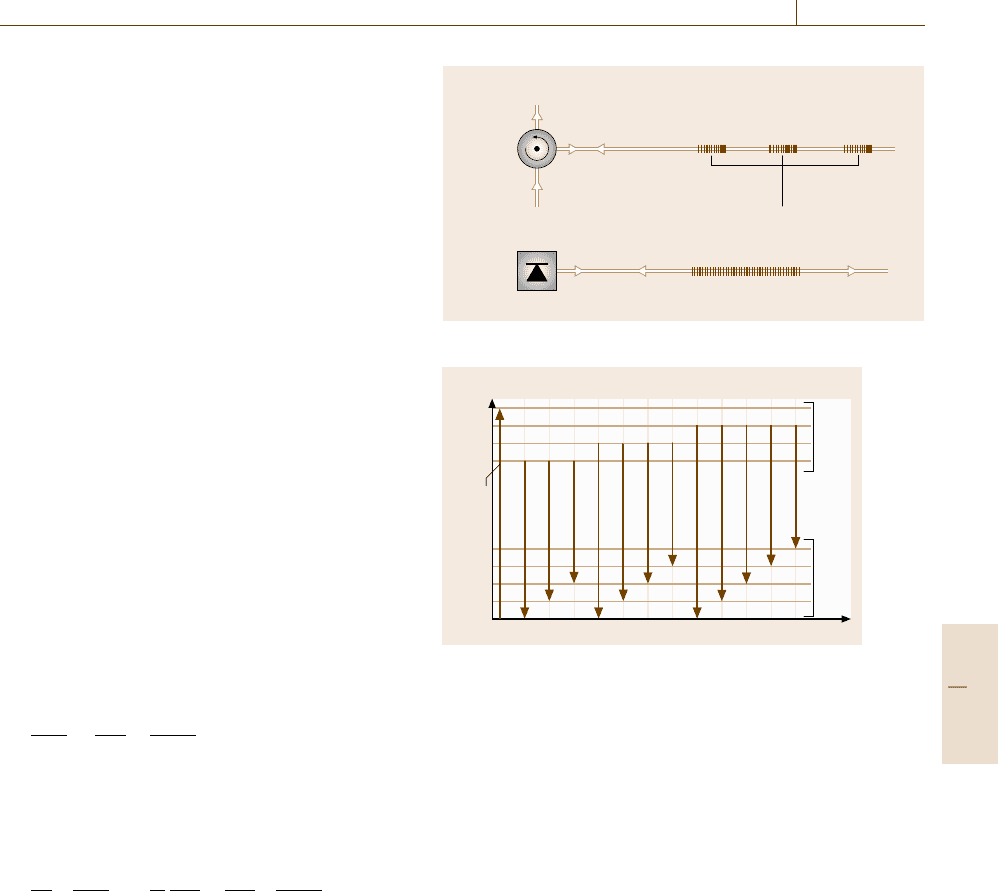
Optical Properties 11.5 Fiber Optics 635
tering, low insertion loss, low back reflection and so
on. So, FBG devices acquired a lot of applications
in the fiber optic communication system in a short
period, e.g., add–drop filtering devices, dispersion-
compensation devices, gain-equalizing filters in fiber
amplifiers, and wavelength locking of pump lasers.
Figure 11.73 shows some examples of FBG applica-
tions in optical fiber communication network systems.
Figure 11.73a presents a schematic diagram of a mul-
tichannel dispersion compensator. FBG devices are
inherently reflection filtering function whereas a trans-
mission device is usually desired. A narrow-band trans-
mission filtering function is commonly realized with the
aid of an optical circulator. Figure 11.74bshowsthe
wavelength locking of pump lasers for Er-doped opti-
cal amplifiers. Feedback of the weakly reflected light
from FBG locks the lasing wavelength of diodes to λ
B
.
The temperature coefficient of the fractional change of
Bragg wavelength, Δλ
B
/λ
B
is ≈ 10
−5
due to the very
stable thermal properties of silica glass. This value is
one order of magnitude lower than the temperature sta-
bility of the wavelength of DFB lasers, and is two orders
of magnitude smaller than the gain peak shift of con-
ventional laser diodes. So, wavelength locking of the
pump laser stabilizes the properties of Er-doped fiber
amplifiers against temperature shifts and aging effects.
A change of the in the value of L and N
eff
causes
a shift of the Bragg wavelength, and the fractional
change, Δλ
B
/λ
B
is given by the equation [11.106]
Δλ
B
λ
B
=
ΔΛ
Λ
+
ΔN
eff
N
eff
,
where ΔΛ/Λ and ΔN
eff
/N
eff
the fractional changes of
the period and effective modal index, respectively. An
axial change results in a shift of the Bragg wavelength
given by the equation
1
λ
B
Δλ
B
ε
=
1
Λ
ΔΛ
ε
+
1
N
eff
ΔN
eff
ε
.
The first term on the right is unity by definition and the
second term, which is approximately −0.27 for silica
fiber, represents the change due to the photoelastic ef-
fect. So, the fractional change of the Bragg wavelength
due to axial strain is 0.73ε. This property of FBGs can
be used in strain sensors [11.106].
11.5.4 Fiber Amplifiers and Lasers
Fiber amplifiers are key components in the current dense
wavelength-division multiplexed (DWDM) telecommu-
nication system. Er-doped fiber amplifiers (EDFA),
a)
b)
Dispersion
compensated
output
Optical
circulator
Pump diode laser
Periodic Bragg grating
to ER doped fiber
Aperiodic
Bragg gratings
Dispersed input
λ
1
, λ
2
, λ
3
,
λ
1
λ
2
λ
3
λ
B
0.98 μm or 1.48μm
Fig. 11.73a,b Some applications of fiber Bragg gratings
6770
6711
6644
6544
268
201
129
55
0
F1 F2 F3 F4 F5 F6 F7 F8 F9 F10 F11 F12
Energy (cm
–1
)
4
I
13/2
4
I
15/2
1.529
1.541
1.559
1.505
1.518
1.535
1.552
1.490
1.502
1.519
1.536
1.552
1.48
(pump)
Fig. 11.74 Energy-level diagram for erbium. Optical gain
occurs in the vicinity of 1.53 μm under pumping at a wave-
length of 0.98 or 1.48 μm (after [11.105])
which have a stimulated emission band in the vicinity
of 1.53 μm, are most widely used as repeaters in the
optical network. Fiber amplifiers and lasers have many
excellent properties, e.g. high efficiency, compactness,
thermal and mechanical stability, and so are used in
many scientific, medical and industrial applications.
This subsection summarizes Er-doped fiber ampli-
fiers and briefly introduces some recent advancements
in femtosecond fiber lasers and high-power fiber lasers
with a double-cladding structure.
Er-doped Fiber Amplifiers (EDFAs)
Energy Levels of Er. Figure 11.74 showsanenergydia-
gram for erbium. Gain in EDFAs occurs in the vicinity
of 1.53 μm when an inversion population exists between
the
4
I
13/2
and
4
I
15/2
states; this is realized by optical
pumping at the wavelengths of 0.98 μm (pumping to
4
I
11/2
)or1.48 μm (pumping to
4
I
13/2
) [11.105,107].
When Er ions are incorporated into the fiber core,
each ion level,
2S+1
I
J
presents Stark splitting due to
Part C 11.5
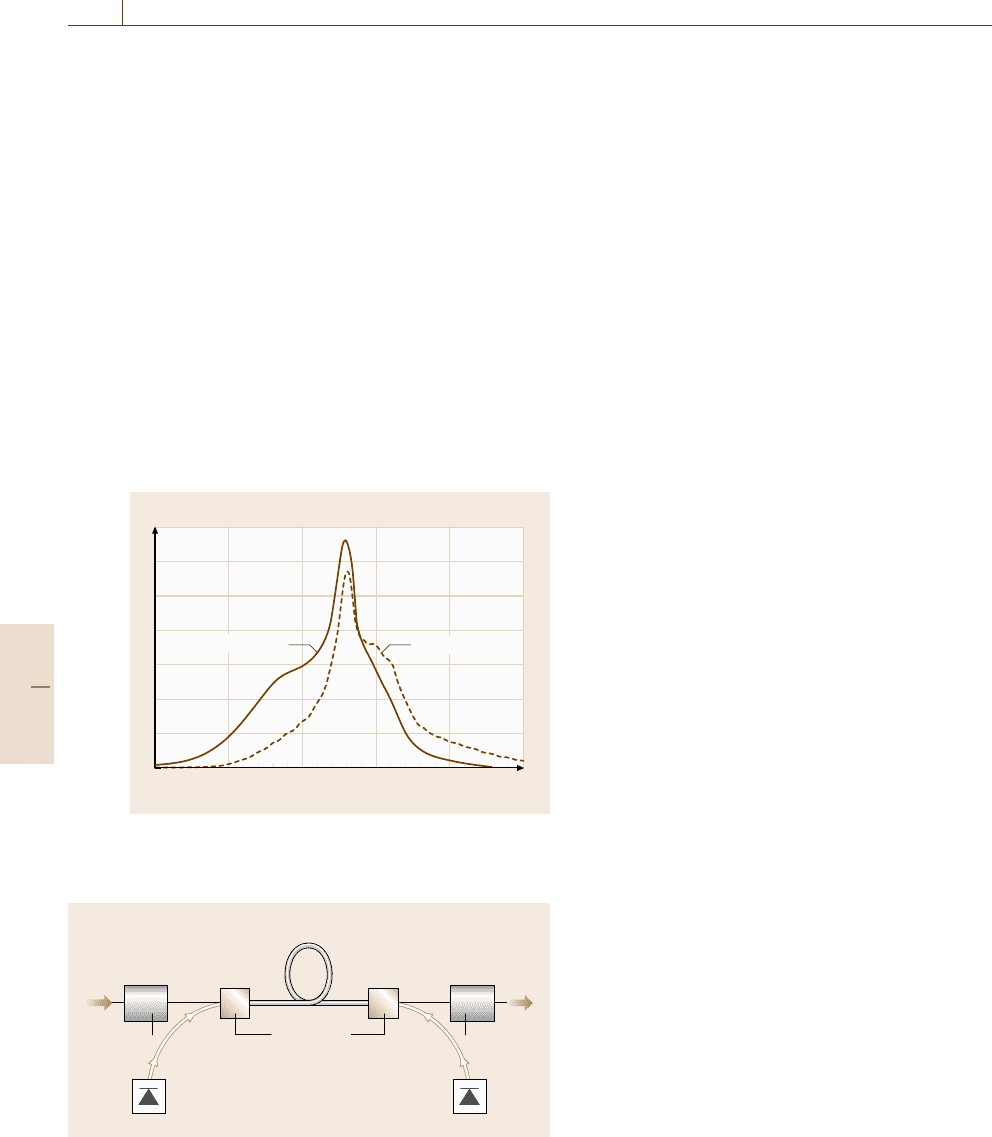
636 Part C Materials Properties Measurement
the interaction between the ion and host matrix. Other
mechanisms, thermal fluctuation and inhomogeneous
environments in the glass matrix further broaden the
emission spectrum. Figure 11.75 shows the absorption
and emission spectra for erbium in silica with aluminum
and phosphorous codoping [11.108]. The spectrum is
constructed from the superposition of the transitions
between the Stark levels and is sensitive to the host
material. Considerable effort has been devoted to ob-
taining broadened shapes for the emission spectra for
a broadband amplifier. Use of alumino-silicate glass
(SiO
2
–Al
2
O
3
) results in slight broadening and smooth-
ing over the pure SiO
2
. The use of fluoride-based glasses
such as ZBLAN provides significant improvements on
spectral width and smoothness [11.109,110].
EDFA configuration. A general fiber amplifier con-
figuration is shown in Fig. 11.76. A typical Er-doped
Cross section (10
–21
cm
2
)
7
6
5
4
3
2
1
0
1400 1450 1500 1550 1600 1650
Wavelength (nm)
Absorption
Emission
Fig. 11.75 Absorption and emission spectra for erbium in
silica with aluminum and phosphorous codoping. Spectrum
associated with the transition in Fig. 11.73 (after [11.108])
1.55 μm
signal in
Isolator Wavelength
selective
couplers
Erbium-doped fiber
Isolator
1.55 μm
signal out
Diode laser at
1.48 or 0.98 μm
– Forward pump
Diode laser at
1.48 or 0.98 μm
– Backward pump
Fig. 11.76 Er-doped fiber amplifier configuration with bidirectional
pumping
amplifier consists of an Er-doped fiber positioned be-
tween optical isolators. Pump light is introduced into the
Er-doped fiber through a wavelength-selective coupler,
which can be configured for either forward or backward
pumping, or for bidirectional pumping. In either case,
pump power is absorbed over the amplifier length, such
that the population inversion varies with position along
the fiber. To get the highest overall effect, the fiber length
is chosen so that the length the fiber is transparent to the
signal at the point of minimum pump power, i. e., the
fiber end opposite to the pump laser for unidirectional
pumping and at the midpoint for bidirectional pumping.
Other factor like gain saturation and amplified sponta-
neous emission (ASE) may modifies the optimum length
of fiber amplifier [11.111]. Optical isolators are usually
positioned at the entrance and exit to avoid gain quench-
ing, noise enhancement or possibly parasitic lasing due
to the unfavorable backscattering or reflected light.
Operating regime. There are three operating regimes,
which depend on the use intended for the amplifier
[11.112]: 1) small-signal, 2) saturation and 3) deep sat-
uration regimes. In the small-signal regime, a low input
signal (< 1 μW) is amplified with negligible satura-
tion. Small-signal gains of EDFAs range between 25
and35dB.Thegainefficiencyisdefinedastheratio
of the maximum small-signal gain to the input pomp
power. Gain efficiencies of well-designed EDFA are
≈10 dB/mW for pumping at 0.98μmand≈5dB/mW
for pumping at 1.48 μm. In the saturation regime, the
output power is reduced significantly from the power ex-
pected in the small-signal regime. Input saturation power
is defined as the input signal power required to reduce
the amplifier gain by 3 dB. Alternatively, saturation out-
put power is defined as the amplifier output when the
gain is reduced by 3 dB. For the power amplifier applica-
tions, where the amplifiers operate in the deep saturation
regime, the power conversion efficiency between pump
and signal is important.
However, to achieve deep saturation the input signal
must be high enough, so the more important situation is
the saturation regime, where the choice of pumping con-
figuration and pump power can substantially influence
the performance [11.112].
Noise and gain flattening. Noise is a very important
factor in telecommunication applications and is quan-
tified using the noise figure. The noise figure of an
EDFA is defined in a manner consistent with the IEEE
standard definition for a general amplifier. For a shot-
noise-limited input signal, the noise figure is defined
Part C 11.5

Optical Properties 11.5 Fiber Optics 637
as the signal-to-noise ratio of the input divided by the
signal-to-noise ratio of the output. The most serious
noise source of EDFA is amplified spontaneous emis-
sion (ASE), which can be reduced by ensuring that
the population inversion is as high as possible. With
0.98 μm pumping theoretically limited noise figures of
about 3 dB have been obtained, while the best results for
1.48 μm pumping have been around 4 dB because of the
difference in the pump scheme [11.113].
DWDM systems needs a flattened gain spectra for
all wavelength channels. Gain-flattening techniques are
classified into three categories. First, use of alumino-
silicate glass or fluoride-based glass with smoother and
broader gain spectra. Second, spectral filtering at the out-
put of an amplifier or between the cascaded amplifiers.
Third, hybrid amplifiers with different gain media in cas-
caded and parallel configurations. Flattened gain spectra
of EDFA have been extended in the range 12 to 85 nm.
For more details of Er-doped amplifiers, excellent re-
views and text books are available [11.111,112,115].
Other Fiber Amplifiers
EDFAs have excellent performances within the con-
ventional gain band (1530–1560 nm) and recent efforts
have resulted in the extension of EDFA gain into the
longer wavelength range (1565–1625 nm). Other rare-
earth dopants or dopant combinations have been used to
produce fiber amplifiers that have gain at other wave-
length region. These include praseodymium-doped fiber
amplifiers, which have gain at 1300 nm and are pumped
at 1020 nm [11.116]. Thulium-doped fibers have been
developed for amplification at 1480 nm [11.117, 118]
and 1900 nm [11.119]. Ytterbium-doped fibers amplify
radiation in the wavelength range from 975–1150 nm
with the pump wavelengths between 910 and 1064 nm.
Erbium-ytterbium codoped fibers provide gain around
1550 nm with the pumping sources, similar to ytterbium-
doped fibers [11.120]. Neodymium-doped fiber ampli-
fiers works in the wavelength range 1064–1088 nm un-
der pumping at 810 nm.
Raman amplifiers have also been developed by us-
ing the fiber transmission line as a gain media to increase
the bandwidth and flexibility of the optical network. Ra-
man amplifiers need multiple high-power pump sources
at different wavelengths to realize broadband amplifica-
tion [11.121].
Fiber Lasers
Fiber lasers are configured by replacing the isolators
at both ends of fiber amplifiers by fiber Bragg gratings
or making a closed loop with couplers. In the case of
a ring laser one need a coupler for the output. Fiber lasers
are inherently compact, lightweight and maintenance-
free, and also do not require any water cooling. So, fiber
lasers have already been deployed in some industrial
applications.
Er fiber lasers can be pumped with telecom-compat-
ible pump diodes and allow for the straightforward exci-
tation of soliton pulses using standard optical fibers. Fig-
ure 11.77 shows a configuration of the passively mode-
locked all-fiber laser, which is referred to as a figure-
of-eight laser because of its layout [11.114]. Nonlinear
all-optical switch including a nonlinear amplifying loop
mirror allows self-starting mode-lock operation for fem-
tosecond pulses. Current passive mode-locking lasers
are usually based on the nonlinear polarization evolu-
tion in a slightly birefringent fiber because they require
the least number of optical components [11.122]. Cur-
rently, mode-locked fiber lasers which generate pulses
with width from 30 fs to 1 ns at repetition rates ranging
from 1 MHz to 200 GHz have been developed in a vari-
ety of technologies. Details of these ultrafast lasers can
be found in the textbook [11.123].
Conventional fiber lasers as well as EDFAs have sim-
ple structures with a single core for guiding both the
signal and the pumped light, implying that single-mode
pump diodes must be used.
The limited available power of single-mode diode-
pumped sources has limited the output power to ≈1W.
Cladding pumping has been developed as a method
to overcome this situation using the so-called double-
clad fiber shown in Fig. 11.78. Double-clad fiber has
a rare-earth-doped core for guiding the single-mode out-
put beam, surrounded by a lower-index inner cladding.
The inner cladding also forms the core for a secondary
waveguide that guides the pumped light. The inner
cladding is surrounded by an outer cladding of lower re-
fractive index material to facilitate waveguiding.
Output
coupler 0.2
Output 1560 nm
Polarization controller
WDM
Pump 980 nm
EDFA
Polarization
controller
Isolator
3 dB
coupler
Fig. 11.77 Set-up of passively mode-locked figure-of-eight
laser (after [11.114])
Part C 11.5
